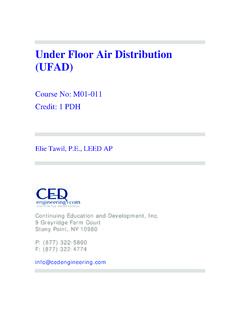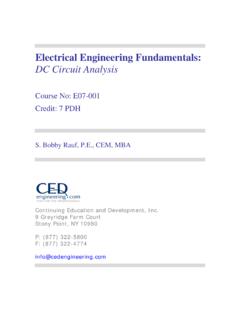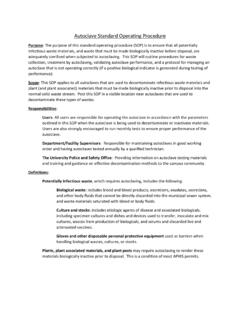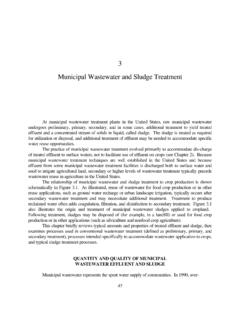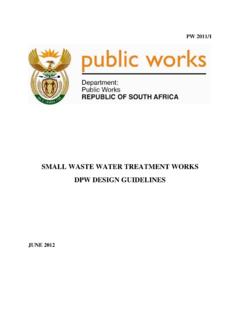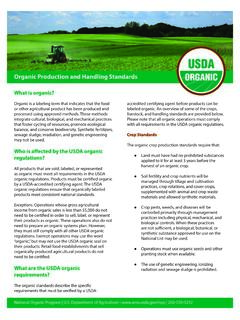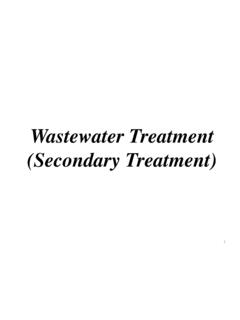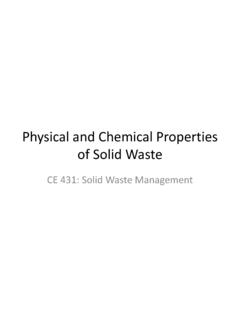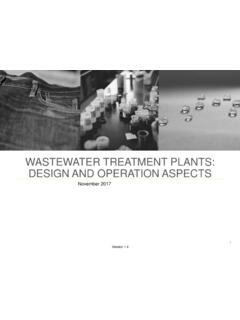Transcription of Biological Wastewater Treatment ... - CED Engineering
1 Biological Wastewater Treatment Processes I: Activated Sludge Course No: C02-066. Credit: 2 PDH. Harlan H. Bengtson, PhD, Continuing Education and Development, Inc. 22 Stonewall Court Woodcliff Lake, NJ 07677. P: (877) 322-5800. Biological Wastewater Treatment Processes I: Activated Sludge Harlan H. Bengtson, PhD, 1. Introduction Biological Wastewater Treatment is very widely used for removal of biodegradable materials from Wastewater . This course starts with a discussion of the biochemical oxygen demand that is created by biodegradable materials in water and the reason why such materials must be removed from Wastewater .
2 The course is primarily about the activated sludge process, including description and background information, as well as presentation of process design calculations and operational calculations. Numerous illustrative example calculations are included for both, along with discussion of the use of Excel spreadsheets for those calculations. This course is Part I of a three-part series. The other two courses in this Biological Wastewater Treatment series are about Moving Bed Biofilm Reactor (MBBR) processes and Membrane Biofilm Reactor (MBR) processes.
3 Activated Sludge Aeration Tank Image Credit: Bergan County Utilities Authority 9E10B1443 AAF&Type=B_LIST. 2. Learning Objectives At the conclusion of this course, the student will Know the equation for Biological oxidation and how it fits into the organic carbon cycle Know the equation for photosynthesis and how it fits into the organic carbon cycle Know the major components of an activated sludge Wastewater Treatment system Be able to describe the differences between an extended aeration and conventional activated sludge system Be able to describe the differences between a contact stabilization and conventional activated sludge system Be able to calculate required aeration tank volume (in units)
4 For a specified volumetric loading, hydraulic residence time, or aeration tank F:M ratio, if given suitable aeration tank influent and aeration tank parameter information Be able to calculate required aeration tank volume (in units) for a specified volumetric loading, hydraulic residence time, or aeration tank F:M ratio, if given suitable aeration tank influent and aeration tank parameter information Be able to calculate the required activated sludge recycle flow rate, waste activated sludge flow rate, and aeration tank F:M ratio, if given suitable Wastewater stream and aeration tank information along with the desired value for sludge retention time Be able to calculate the required air/oxygen blower requirements and alkalinity requirements for an activated sludge process.
5 3. Topics Covered in this Course I. biochemical Oxygen Demand as a cause of Water Pollution II. Description of the Activated Sludge Process III. Activated Sludge Process Variations IV. Activated Sludge Parameters V. Activated Sludge Process Design Calculations VI. Activated Sludge Operational Calculations VII. Oxygen/Air/Blower Calculations 4. Biochemical Oxygen Demand as a Cause of Water Pollution Biochemical oxygen demand (BOD) is an indirect measure of the concentration of biodegradable organic matter in water or Wastewater . Organic matter (as measured by BOD) is one of the major constituents removed from Wastewater in domestic Wastewater Treatment plants.
6 The reason for being concerned about organic matter in water is its effect on dissolved oxygen in the receiving stream. Dissolved oxygen in water is essential for much of aquatic life, so organic contaminants that affect dissolved oxygen level in water are of concern. The death and decay portion of the organic carbon cycle shown in the above diagram is the portion that takes place in the Biological Treatment component of a Wastewater Treatment plant or else takes place in the receiving stream if the organic matter isn't removed in the Treatment plant.
7 The two major reactions that take place in the organic carbon cycle are Biological oxidation of waste organic matter and photosynthesis, which is the process by which green plants produce organic matter from carbon dioxide and water in reactions that are catalyzed by sunlight and the chlorophyll in the green plants. Through the Biological oxidation process, aerobic microorganisms utilize oxygen in breaking down organic matter to carbon dioxide and water together with small amounts of other end products. The photosynthesis and Biological oxidation processes can be represented by the following two equations: Photosynthesis: CO2 + H2O + sunlight organic plant matter (primarily C, H, & O) + oxygen (this reaction is catalyzed by the chlorophyll in green plants).
8 Biological Oxidation: waste organic matter (primarily C, H & O) + O2 CO2 + H2O + energy This reaction is the death and decay' shown in the organic carbon cycle diagram. The process takes place as aerobic microorganisms utilize the waste organic matter as their food (energy) source. The process uses oxygen, so if it is taking place in a water body, dissolved oxygen is consumed. A large quantity of organic matter in the water will result in multiplication of microorganisms and rapid removal of dissolved oxygen, leading to oxygen depletion below the level needed by aquatic life.
9 This is also the process that takes place in Biological oxidation processes in Wastewater Treatment plants for removal of organic matter from the incoming Wastewater . 5. Description of the Activated Sludge Process The activated sludge process is very widely used for Biological Wastewater Treatment . The figure below shows a general flow diagram with the typical components present in an activated sludge Wastewater Treatment plant. Activated Sludge Wastewater Treatment Flow Diagram The first component is preliminary Treatment , typically consisting of screening, flow measurement, and perhaps grit removal.
10 The second component, the primary clarifier, is used to remove settleable suspended matter. The underflow goes to sludge Treatment and disposal and the overflow goes to an aeration tank. The aeration tank is the heart of an activated sludge Treatment process. It is here that Biological oxidation of dissolved and fine suspended organic matter takes place. The Biological oxidation takes place because aerobic microorganisms, organic matter and dissolved oxygen are all brought together in the aeration tank. The organic matter comes in with the primary effluent.

